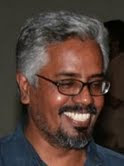On a Great Actor

A Thespian Leaves The Stage
The departure of the thespian Ammannur Madhava Chakyar (1917-2008) marks the end of a long, tumultuous yet glorious era in the classical art performance of Kerala. An all time great of Kudiyattam*, he was the one remaining vibrant link connecting the present generation of viewers and artists with the brilliance and also the rigours of a past that had endured many a moment of highs and lows. For, his life spanned the entire history of modern Keralam. Coincidentally, he was born in the year of the Russian Revolution, a historic event that was soon to have deep repercussions on his own society, community, life, and vocation. Spending his childhood during the last heydays of an economic system – the temple economy that sustained and sponsored art forms like Kudiyattam and temple-dependents like Chakyars – he had the fortune to get early training under the tutelage of his uncle the legendary Ammannur Chachu Chakyar, one of the all-time-greats of Kudiyattam. By the time he grew up into an able and noted performer, the temple economy that sustained his art was in shambles. Moreover, the social changes that were sweeping Kerala had other concerns and priorities, and naturally, classical arts like Kudiyattam were not at the top of the list. With the spread of secular art forms, the once elite and popular art forms - both classical and folk – entered the 'endangered' list. Even with the establishment of Kalamandalam, it was Kathakali that got more prominence and international visibility, and not a 'difficult' art like Kudiyattam. Ironically, many of these rich traditions of performance survived through sheer conservatism, and the total commitment and dedication of the practitioners who went on performing (most of the time ritually) despite the shrinking material support and an indifferent audience. No wonder, for Ammannur, performance was like prayer, while he performed, he never saw an audience in front of him, he instead played to the flame of the Nilavilakku lit in front of him. It is this intense and exuberant belief in oneself and one's art, and the understanding and realization of that art as a 'medium' (in the real sense) that must have sustained the likes of Ammannur through those difficult times.
From the early days, Ammannur was noted for his talent that was burnished through training under scholars like Kodungallur Kochunni Thampuran. By the 60's he was considered one among the trinity of Kudiyattam, along with Painkulam Rama Chakyar and Mani Madhava Chakyar. But unlike the other two, Ammannur's career spanned the very history of Kudiyattam across 20th century. For, he entered the scene in its glorious days, spent his youth while it began to be derided, even ridiculed and marginalized, then later, was witness to its gradual resurgence and ultimately, its growing international and local recognition when he reached old age. His life encapsulates the history of the art in many ways; it was a journey from the elite confines of the koothambalam into the open, secular spaces, from obscurity to worldwide renown, from the local to the universal, from the select or condemned few of performers to the secular-many.
Among the trio, though Ammannur was known more for his vacika, and for his mercurial vidusaka, he also shined in other departments, immortalizing characters like Ravana (Thoranayuddham), Bali (Balivadham), Arjuna (Subhadradananjayam) etc. Who can ever forget his performance of the extended death throes of Bali, and the dillydallying Siva, a Lord torn between his love for Parvati and Ganga?
Like his legendary ancestors, he too was vitriolic in his humour; and for him, humour was not just drawn from local scandals as in the case of many of his contemporaries, or mere buffoonery. He brought his deep knowledge of the puranas, mastery over language, and more importantly, understanding about current affairs, into his humorous discourses.
I still remember those dark days of Emergency, when during his performance at Irinjalakuda as Vidusaka, he deliberately wove the political context looming large into his performance, reminding and warning the viewers of its monstrosity, subtly yet very pungently. Thus he in fact re-claimed the essence of being a chakyar today, that of being a critic of the powers-that-be and of speaking truth to power. As he aged, his mastery over all departments blossomed, his angika-abhinaya was graceful and chiseled, and his command over vacika also attained a matured beauty. He was an artist for whom his art was the be-all and end-all of everything. He continued performing, totally engrossed with himself and that enigmatic flame in front.
Actually, the credit for taking Kudiyattam out of the confines of the koothambalam goes to the progressive and daring Painkulam. And it was later popularized by the charming presence of Mani Madhava Chakyar. In the case of Ammannur, it was the very same conservatism that sustained the rigours of the art through the ages that prevented him from coming out. He was the last to come out and perform outside the koothambalam, but once he came out, his brilliance was readily appreciated and recognized all over the world. He not only carried the art to the next century, he was also instrumental in rearing a new generation of Kudiyattam artists and honing the skills of some of the best talents in the art today like Kochukuttan Chakyar, Usha Nangiar and Margi Madhu. His brief but influential stint at Margi School inspired a generation of viewers and disciples.
Now the great thespian has left the stage leaving behind memorable performances and a great legacy.


0 Comments:
Post a Comment
Subscribe to Post Comments [Atom]
<< Home